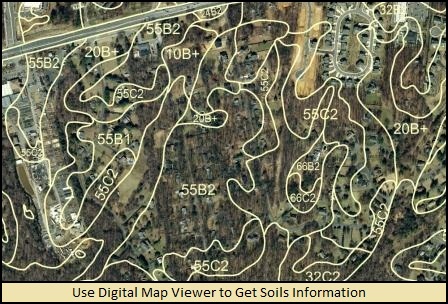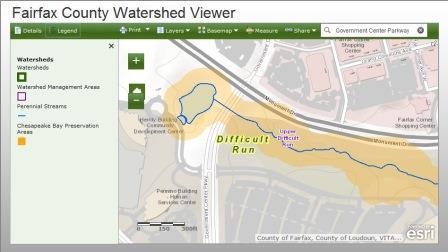Wet areas that last for months or are always present, appear to be independent of rainfall.
Surface sogginess and persistent puddles that appear to be independent of rainfall and last for months or are always present can be indications of a spring, a leaking water pipe or high groundwater.
 Small Wet Area, Regardless of Weather: Leaking Pipe or Natural Spring »
Small Wet Area, Regardless of Weather: Leaking Pipe or Natural Spring »
 Large Wet Area for Months: High Groundwater »
Large Wet Area for Months: High Groundwater »
Small Wet Area, Regardless of Weather: Leaking Pipe or Natural Spring
If you have prolonged wetness confined to a specific area or water literally flowing or seeping out of a hillside, you likely have a leaking pipe or a natural spring.
1. Is it a leaking pipe?
 A leaking pipe can occur anywhere on your property that pipes are buried, but water from the pipe may travel underground before coming to the surface. Leaking pipes may include sprinkler systems, irrigation pipes, drinking water or even wastewater. There are two simple ways to determine if you have a leaking pipe.
A leaking pipe can occur anywhere on your property that pipes are buried, but water from the pipe may travel underground before coming to the surface. Leaking pipes may include sprinkler systems, irrigation pipes, drinking water or even wastewater. There are two simple ways to determine if you have a leaking pipe.
Test the water. The first thing you can do is test the water coming from the leak to see if it contains chlorine or fluoride. If so, the water is from a municipal water pipe. Fairfax Water will take the sample and perform the necessary tests for you. If you strongly believe that you have a leaking pipe but the water sample comes back negative from Fairfax Water, you may consider submitting the sample to a private lab for a fee. Some private labs use tests that are more sensitive than that of Fairfax Water.
Watch the water meter. The second test involves shutting off the main water valve to your house and observing your meter. If the meter continues to run, you have a leak between your meter and your valve. Meters outside the home may be difficult to find or located underneath a manhole cover. For more information on leaking pipes, please contact Fairfax Water at 703-698-5800, TTY 711. Homeowners are generally responsible for maintenance of waterlines from the edge of the street to the home. If the leak is within this span, you will need to call a plumber and fix the pipe yourself. Otherwise, Fairfax Water is responsible for repairs.
2. Is it a natural spring?
 If there is no leaking pipe, you probably have a spring or seepage. Natural springs tend to occur on hillsides. If you have marine clay soils, you have a higher likelihood of finding a spring on your property.
If there is no leaking pipe, you probably have a spring or seepage. Natural springs tend to occur on hillsides. If you have marine clay soils, you have a higher likelihood of finding a spring on your property.
Natural springs have many environmental benefits. They are important natural sources of clean water for wildlife. Planting around the spring can improve the aesthetic value and turn it into an amenity for your landscape. Strategies to redirect or capture runoff » can also be used.
Large Wet Area for Months: High Groundwater
 High groundwater (at or near the surface) during much of the year is often seen where there is:
High groundwater (at or near the surface) during much of the year is often seen where there is:
- Low-lying land near streams and floodplains or
- Soil with a dense, impermeable layer.
In these areas, widespread sogginess and puddles on the surface of your property can last for days, weeks or months, especially during winter months when trees are dormant and their roots are not extracting as much water from the soil.
You can confirm high groundwater using the Fairfax County soil maps to identify the soil types on your property. The Fairfax County soil maps can be accessed on the Fairfax County Digital Map Viewer. The map will give you soil numbers, then use the Soils Map Guide to learn about the characteristics of your soils, including if it has high groundwater. You can also call or email the Conservation District (703-324-1460, TTY 711).
Areas with high groundwater can include protected wetlands or a Resource Protection Area (RPA), also known as Chesapeake Bay Preservation Area. Land clearing work within these areas is highly restricted. To determine if your property is in an RPA, use the Fairfax County Watershed Viewer. Enter your address to find your watershed, nearest stream and Resource Protection Areas. You can also contact the Conservation District (703-324-1460, TTY 711). District staff can help explain your options if your land is in an RPA.
1. Replant with water-tolerant species, preferably native.
Why fight Mother Nature? The best option in a widespread soggy area is to replant with water tolerant species, preferably native plants. Plants will aesthetically improve the soggy spot, restore wildlife habitat and they can also slowly improve the soil’s infiltration capacity by physically conditioning the soil with their roots and organic matter.
2. Underground drainage system
Little can be done to alleviate the problems of high groundwater without significant effort and cost. If the wetness problem is not affecting the foundation of your home, it is often best to simply replant with water-tolerant species. If you feel that something must be done to alleviate the drainage, an underground drainage system may be installed on your property ONLY if your land is not within an RPA (or other protected area) or you can obtain the necessary permit to work in protected land. Underground drainage systems are expensive and time-consuming to install. A skilled contractor would likely need to be hired.



